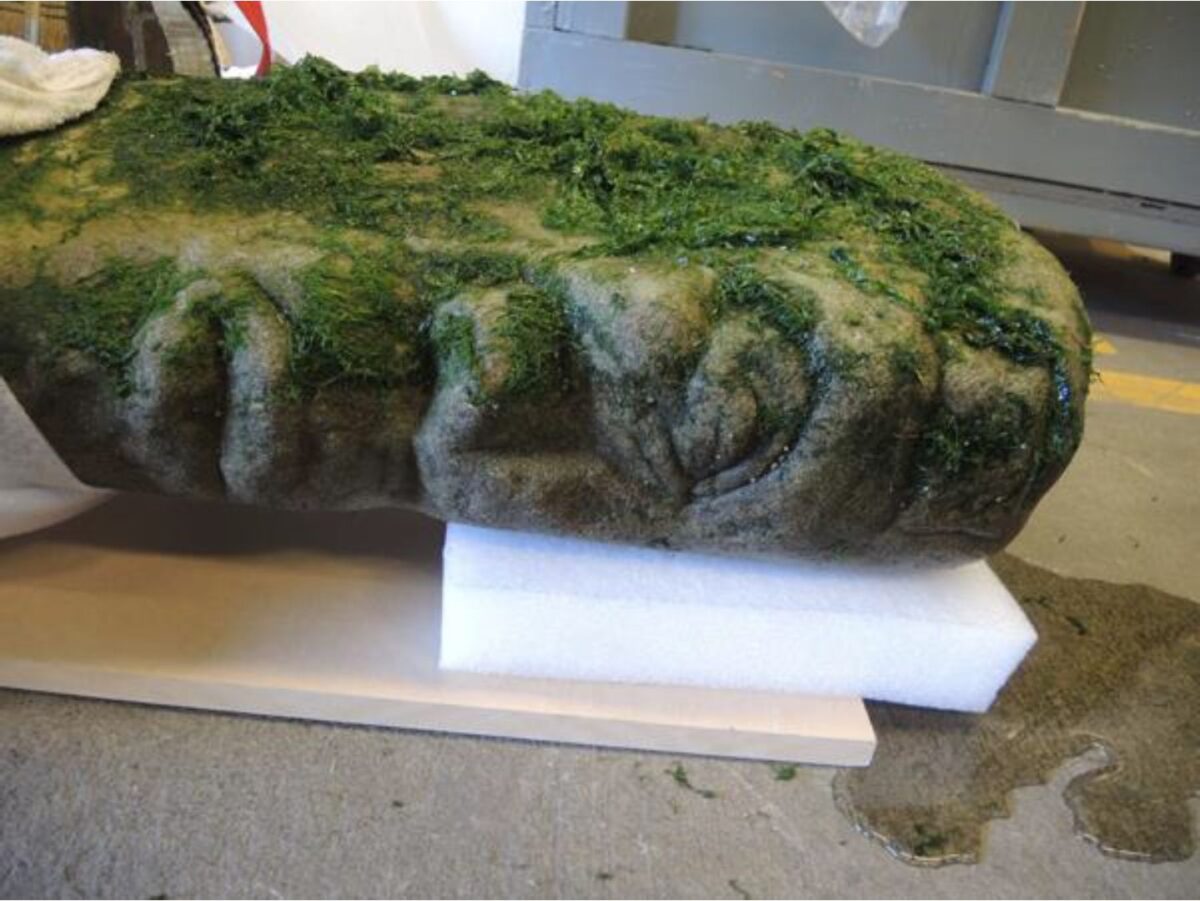By Grant Keddie
2021.
By Grant Keddie
In the summer of 2020, I recovered a large 240 lb stone figure with a team of four others from the waters near Finlayson Point on the southern shores of Victoria (see Appendix 1). At the time I looked at the cultural context and physical evidence and determined that I would treat the cultural landscape and oral history as the more favourable evidence that the stone figure was likely to be an old Indigenous ritual figure.
It turned out that I initially erred on suggesting that the stone figure was an old one when a modern-day stone carver told the media that he carved the stone. Here I provide a summary of how I came to my initial conclusion and how there is still some confusion as to when the figure was carved and a mystery about how the stone figure ended up where it did.
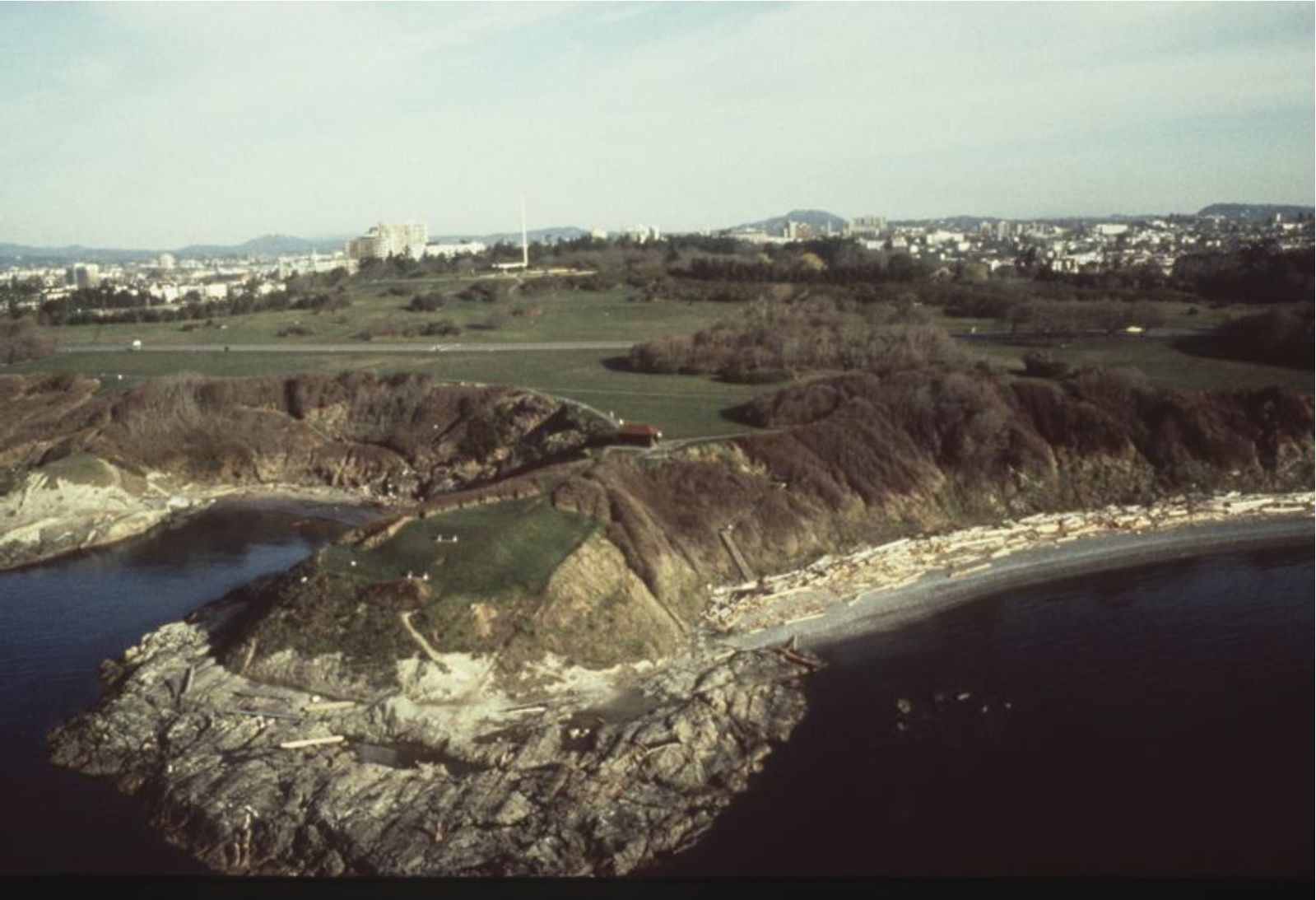
The Cultural Context
Finlayson Point on the southern coast of Victoria and the surrounding landscape is a significant part of the history of the Lekwungen people. The entire peninsula of Finlayson Point was once a defensive village site and still contains the buried cultural deposits that I dated to the time period between 1000 and 350 years ago (Keddie 1993). The burial cairns of the people who lived here once extended from the top of Beacon Hill and along the eastern ridge below. Some cairn remnants, along with the four larger ones I worked on reconstructing with the city in 1985, are still here.
Lekwungen advisors in the 1880s presented the oral history of activities surrounding special stones that occurred “not far” from Finlayson Point. They indicated: “If a man desires a certain wind, he moves one stone a very little from its place, each stone representing one wind. If he should move it too much the wind would be very strong”. It was also a place that a girl “when reaching the age of puberty, must take some salmon to a number of large stones” (Boas 1891).
Special stones of this nature, 12km away in Cadboro Bay, were also described by a Lekwungen elder in the 1890s as occurring in the form of “two square pillars about six feet high, set on end as to form a doorway”. Another rock named Yicsak, was a rough block of layered sandstone with one layer forming a rim around the top that looked like a hat. The block was sitting on a glacial boulder and “seen from a distance, may easily be taken for the image of a small boy with a large hat on his head, sitting on a block of stone”. Dances were performed around the rock and it was treated with a coating of fish oil. When bad weather prevented the Lekwungen from fishing about 1840, the elder remembered as a child going with his father on a stormy day to rub Yicsack and the pillars. The stone was last rubbed in 1880 and still stood there in 1891 (Deans 1891; Keddie 2012).
It was an unusual coincidence that a modern stone carving on a large shaped sandstone slab with a carved face on one edge, was found in the water within the context of this Lekwungen landscape, not far from Finlayson Point. If it had been found in a context lacking oral history I would have been much less inclined to consider it as an older object.
The Oral History vs. Physical Evidence
When Bernhard Spaltholz sent the Museum images of a large stone carving found at a zero tide not far off Finlayson Point, I at first considered that the stone may be of more recent origins (figure 2). I thought it could be a garden gnome, as the city of Victoria had dumped city garbage from a barge off shore until the 1970s.
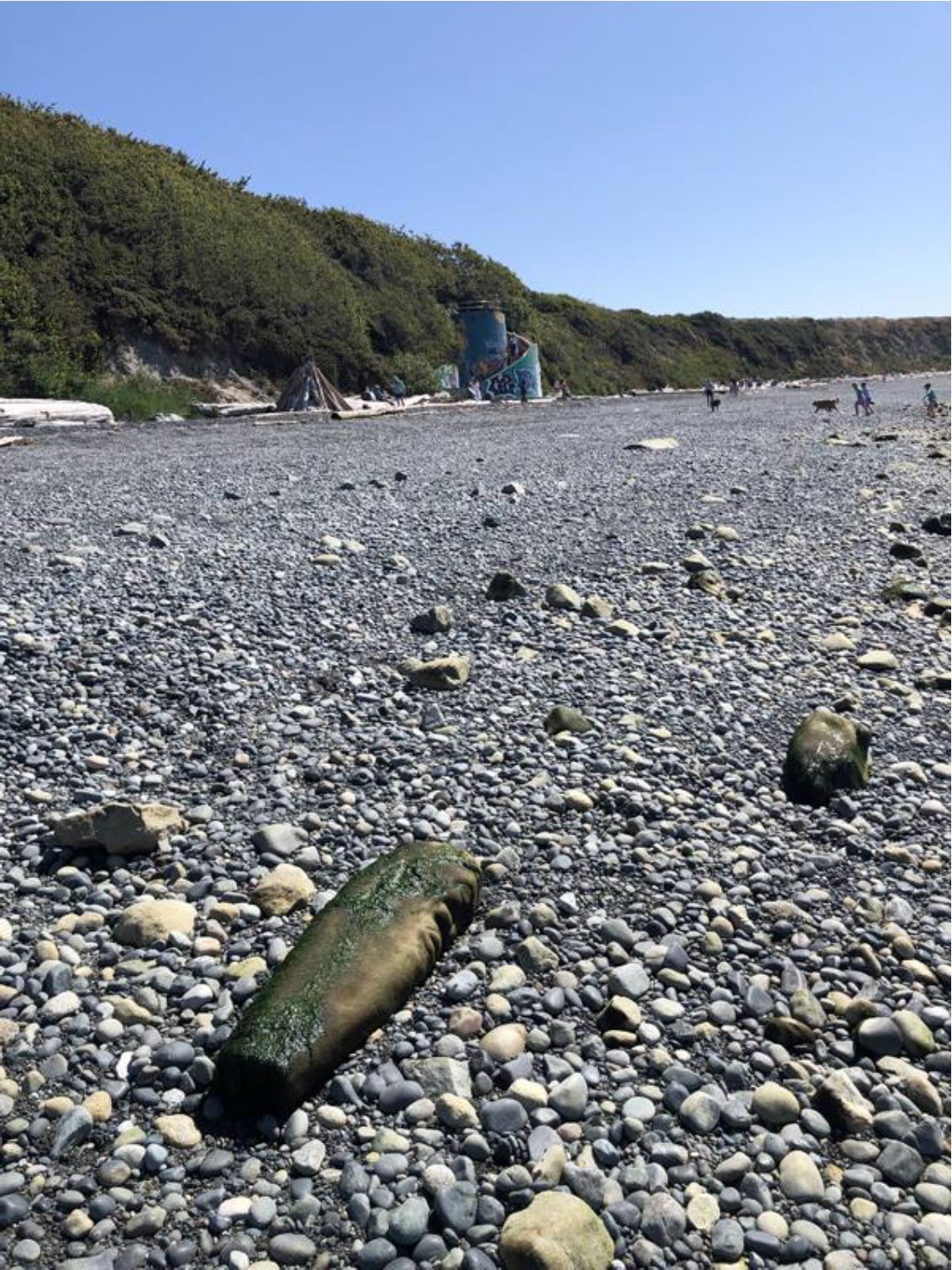
I was also aware of the enormous diversity of physical appearances of Indigenous stone figures that have been found on the southern coast of British Columbia. It was rare to find any two that looked remotely alike and none looked like known historic Indigenous Images. This figure, or any other large stone figures that have been found, could not be placed in any standard type (Keddie 2003; figure 3 andfigure 4). I recognized that there were similar bulbous faced images on smaller artifacts, such as that seen on an antler adze handle from the Ozette site on the Olympic Peninsula, but these all had very different functions (figure 5).
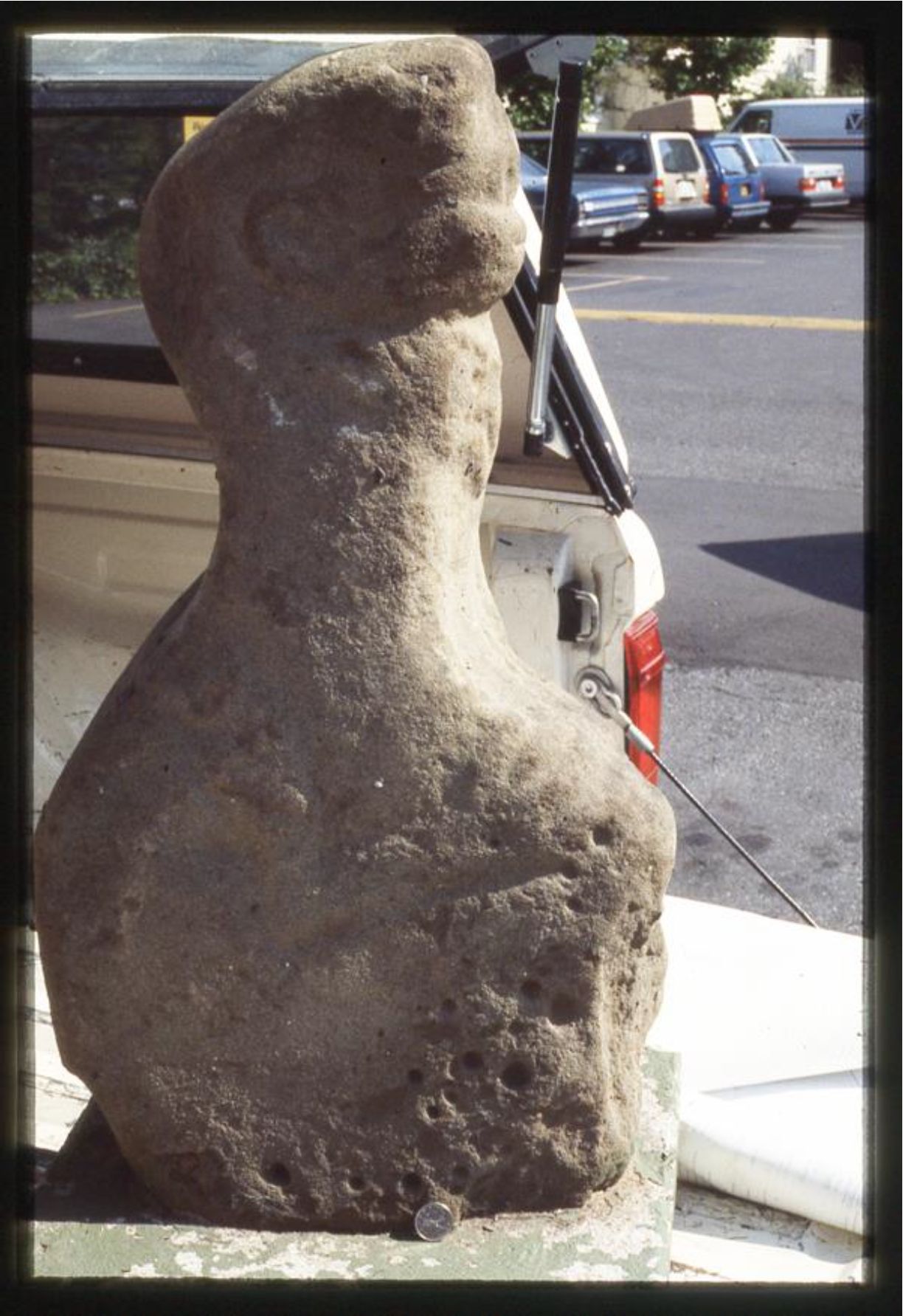
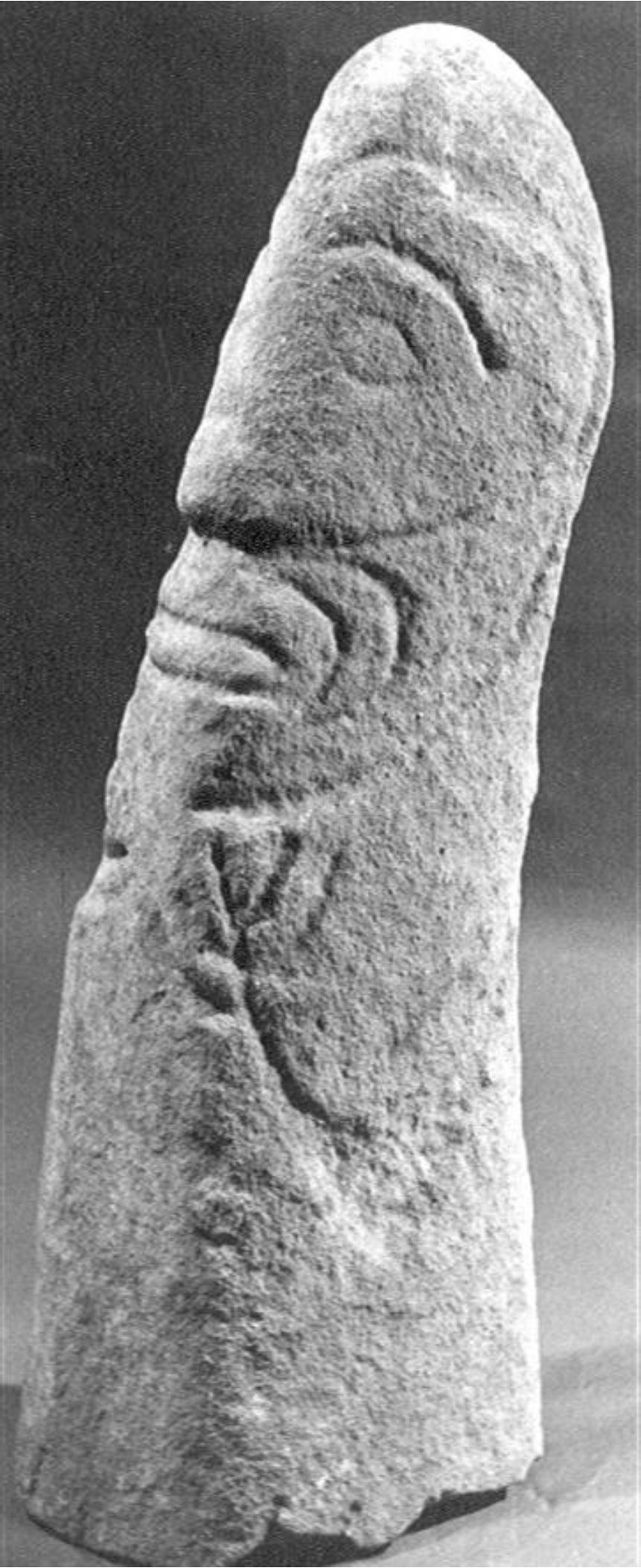
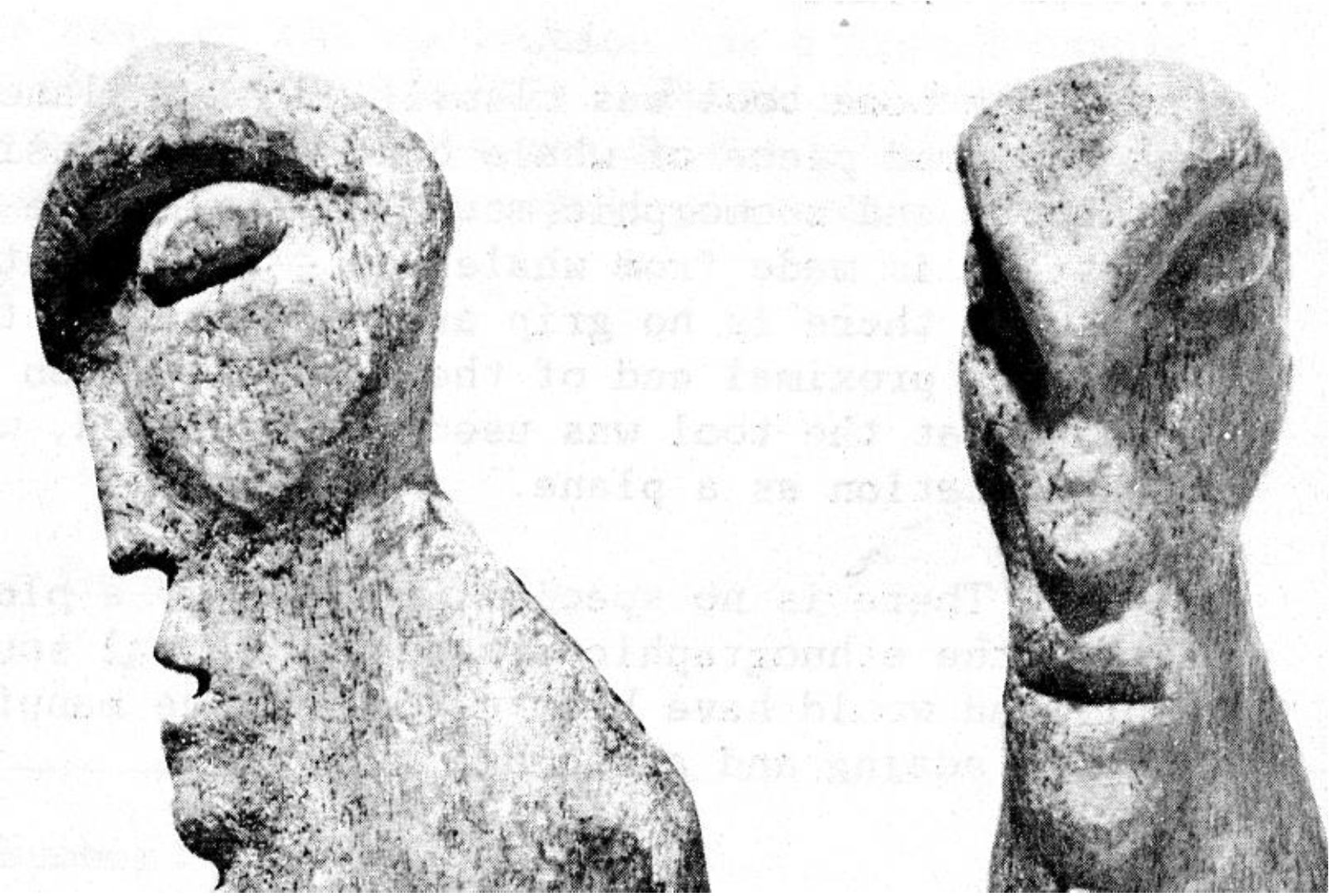
Given these uncertainties as to what the artifact was, I thought it was important to find and examine it before someone else found and removed it. The artifact was not on a protected archaeological site and being in its water location, not protected by any underwater marine laws. At the time, I did not want any media attention until I had examined the artifact. I earlier contacted Chief Ron Sam of the Songhees Nation indicating that the object might be Indigenous.
When I had the chance to briefly examine the stone on the beach it was covered in green algae, looked weathered and showed no obvious evidence of iron tool cut marks. In retrospect these could have been weathered away because of the softness of the sandstone.
Given the lack of physical evidence of the stone being of a recent nature, my most important consideration was the fact of Indigenous Lekwungen oral history that told of ritual stones occurring around this locality. This provided the stone with a potentially significant cultural context. Given the high cultural importance of large stone figures such as this, it was important to side with oral history and preservation. Some of the known large stone figures, from an Indigenous perspective, are containers of power related to the interaction between humans and the spirit world.
The best expression of the cultural value of large stone figures and what they mean to Indigenous cultures can be found in the oral histories of the stone known as T’ixwelatse. The latter stone was recognised as the first male ancestor of the Ts’elxweyeqw (Chilliwack) Tribe (Schaepe and Joe 2006; see the Stolo web site).
I decided it was best to get the stone figure safely off the beach for further examination. This turned out to be a much harder process that expected. We later found the stone to weigh 240 pounds. As the stone was going through the conservation process of leaching out the salt in successive patches of fresh water, I did not have the opportunity to do a more thorough examination by magnification which I had intended to do once it was cleaned. I was also thinking of undertaking x-ray florescence to determine the source of the sandstone. As soon as the Conservation work was completed the Museum invited members of the Songhees and Esquimalt Nations to have a private behind the scenes showings of the stone with covid restrictions in place. Even after this covid isolation prevented further examination of the artifact.
Further Consideration
There were a number of things I had to consider to determine if this was an Indigenous artifact. I was aware of the recent stone carvings done on Clover Point but those were carved into the face of stone slabs and boulders, not large threedimensional elongate sandstone slabs that had been heavily ground into shape.
I had walked the beach in this area many times observing the stratigraphy of the local eroding cliffs and searching the beach for fine grained stones to use in my tool technology demonstrations. I was aware that there were a small number of chunks of sandstone, and one former sandstone building block (Figure 6) among the many tons of rock brought in by the city of Victoria and placed along the west side of Clover Point to prevent erosion. I also know that there were no natural occurrences or dumped sandstone slabs along the rest of the waterfront extending to Finlayson Point. As I use sandstone slabs to demonstrate the grinding of slate and shell artifacts, I often watched for these. Figure 7 shows a rare example of a large slab of unidentified stone eroding down Dallas bank. From its location I could not determine if it was natural to the deposits or slumped down from later historic dumped material.
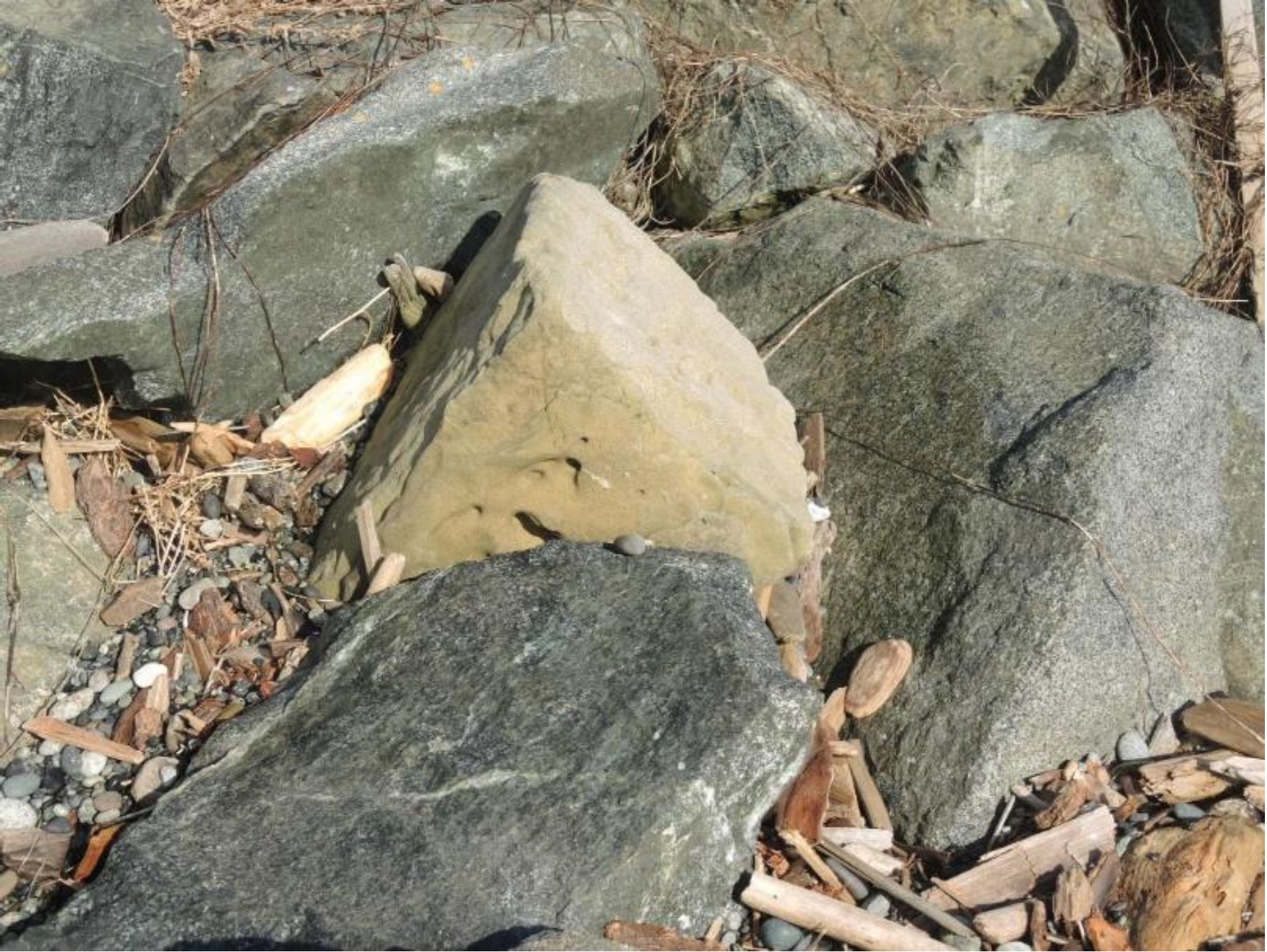
Sandstone is not a natural occurring rock found in the area and must have been brought from somewhere else. I considered whether the large sandstone slab was an old partially shaped ritual stone pillar that had slumped down the bank of a more extended shoreline cliff and was subsequently found and carved in recent times. Landslides of large sections of the bank have been common in this area for many years.
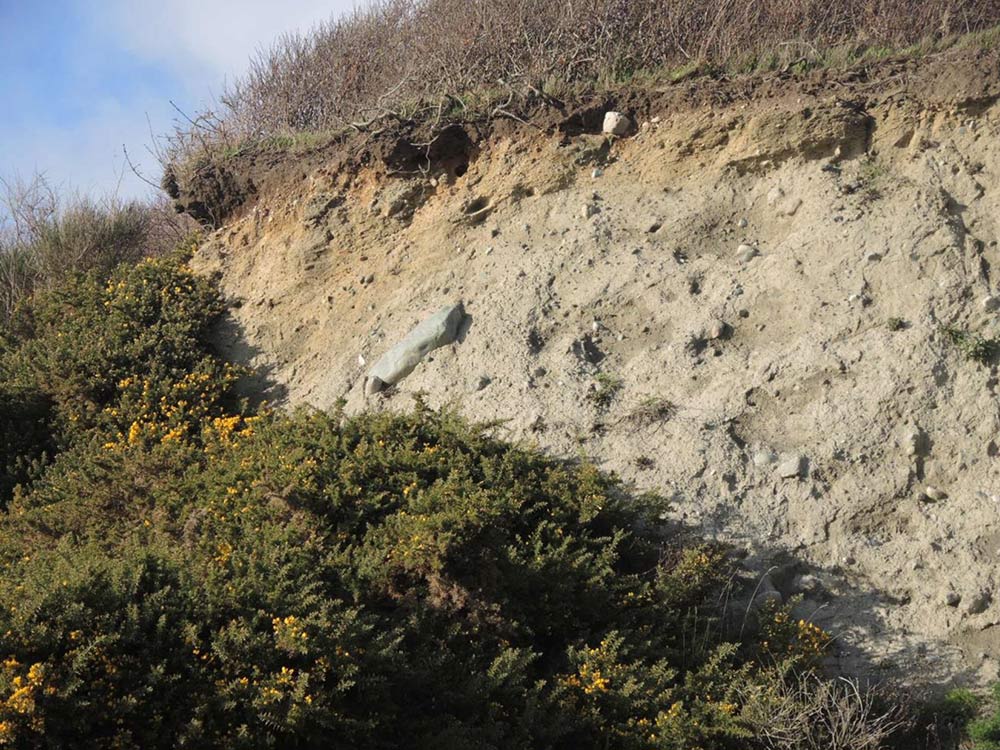
After my experience of the team effort that went into moving the 240 lb stone out of the water, the only way a modern stone figure would end up at this offshore location would be through efforts of a team of people deliberately placing it there with the appropriate equipment to move it. I could envision a heavy-duty wheel borrow being placed on its side and the figure flipped by at least two people into the side of the wheel borrow and then levering the other side of the wheel barrow while lifting the lower part to get it in. The figure could then be wheeled down the hard packed portions of the beach at low tide and dumped into the water.
Over the last 50 years I have had a number of people bring artifacts into the Museum that are modern fakes and they or the people they acquired them from did not tell the truth about where they found them. Sometimes they wanted to sell it, know if there was a reward for discovering the object, or wanting to suggest it was evidence for some unorthodox idea of theirs, such as whether or not they came from Easter Island. One extreme example from the mid 1940s was the faking of about 90 stone figures by a Vancouver antique dealer who claimed they came from a large mound in the Lower Fraser valley. He even faked excavation notes. I, at first, dismissed the idea of a deliberate hoax regarding the recent stone figure as it seemed at the time that it would require a lot of effort.
How exactly the Lekwungen peoples moved large rocks in the past is not known but they obviously had the ingenuity to move these with levers and other devices, as evidenced by half ton boulders in the burial cairns on the local landscape.
Given the evidence at the time, I feel I made the right decision when I erred on the side of oral history and of the stone being a potentially important cultural object.
The Carver of the Stone and the Media
When I heard the story of Ray Boudreau announcing that he had carved the stone the evidence was based on what was considered fool proof by the media – images that looked like the figure with a date stamp. However, anyone can Google how to change a stamp date on an iPhone – this was not the proof. The photograph was not very clear, photographs can be faked, but this one did appear to show part of the stone figure in an unfinished state. There were some differences that I observed between the photo and the figure found in the water, but since it was unfinished that difference could be explained by it being changed after the image was taken.
I could not respond to the Media at the time, as I was instructed not to talk to anyone, and another person was assigned to take over responses to the media. This resulted in a lot of speculation in the media.
The Convincing Evidence
What was the convincing proof for me that the stone was modern was when I examined the Clover Point carvings of Boudreau more closely. The details in the carving of the eyes in one of the figures clearly resembled the one eye in the recovered stone figure. The double ridge below the eye being unique.
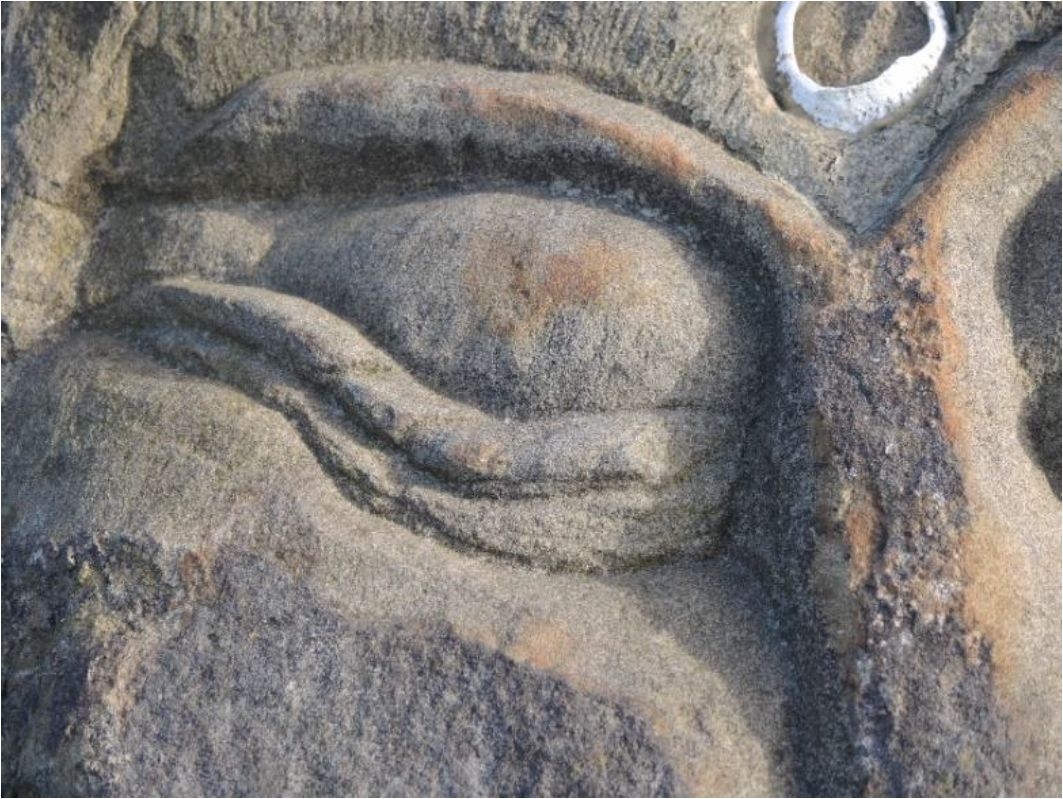
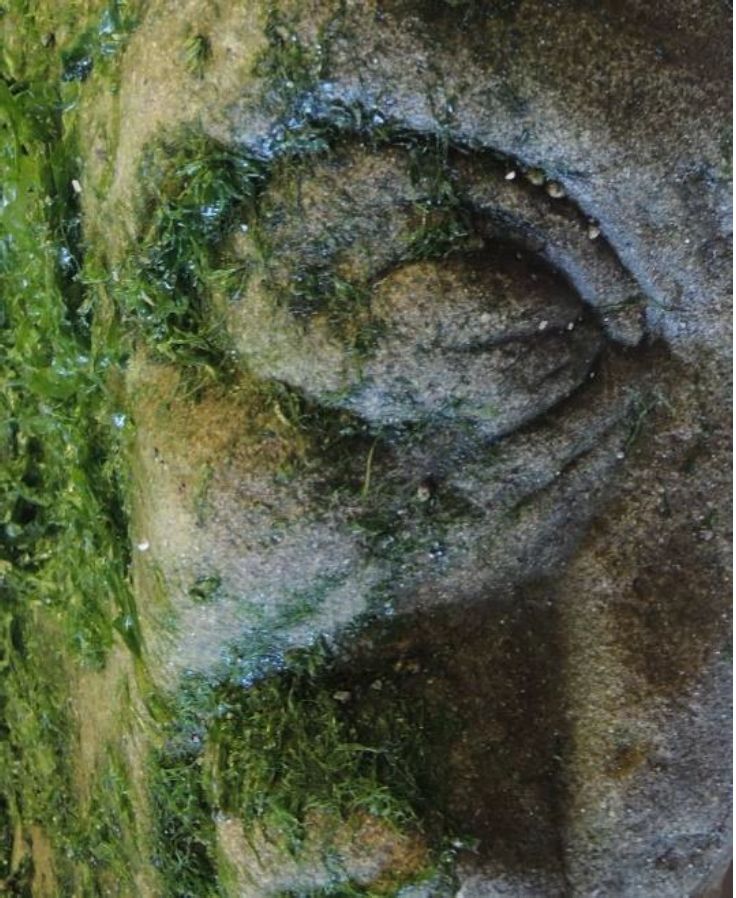
Now that I could see this was in fact a modern carving it became important to know how it ended up in the context of this ancient landscape.
Contradictions in the Information
There were some unusual contradictions as to when the sandstone was found and carved. Boudreau only had it for three days before it “disappeared” or “was stolen”. One news story said they received an image of the stone stamp dated Jan. 23, 2017, and another news outlet said they received an image stamp dated in July of 2017 and Boudreau was reported as saying that he came across it on the beach in July.
Boudreau himself was quoted to suggest that the stone was found at a different time. On January 31, 2021, The Times Colonist reports: “Boudreau knew the stone was unusual. He found it a couple of days after two barges smashed into the shore near Dallas Road and Cook Street in late February 2016. One of the barges was loaded with heavy scrap and construction debris such as concrete and pilings from the Coho ferry terminal construction site”.
The barge beaching event happened on March 2, 2016. The newspaper statement would therefore indicate that Boudreau found the stone on March 4 of 2016 not in 2017, when his time stamped photograph was taken during the three-day period he had it.
I visited the barge location on March 4, and did not see any material that had fallen overboard (Figure 10). Two barges broke from a tug boat and were blown to shore in high winds. One barge, carrying a crane and fuel, initially landed on Finlayson Point before drifting west to the rocks below Olympia Avenue. It was removed on March 3.
The second barge stranded on the beach to the east of the spiral staircase below the end of Cook Street. The Victoria Buzz reports on March 9, 2016 that: “construction materials have fallen in and around the Cook Street location”. The barge was removed on March 18. This location is well east of the beach where the stone figure was found.
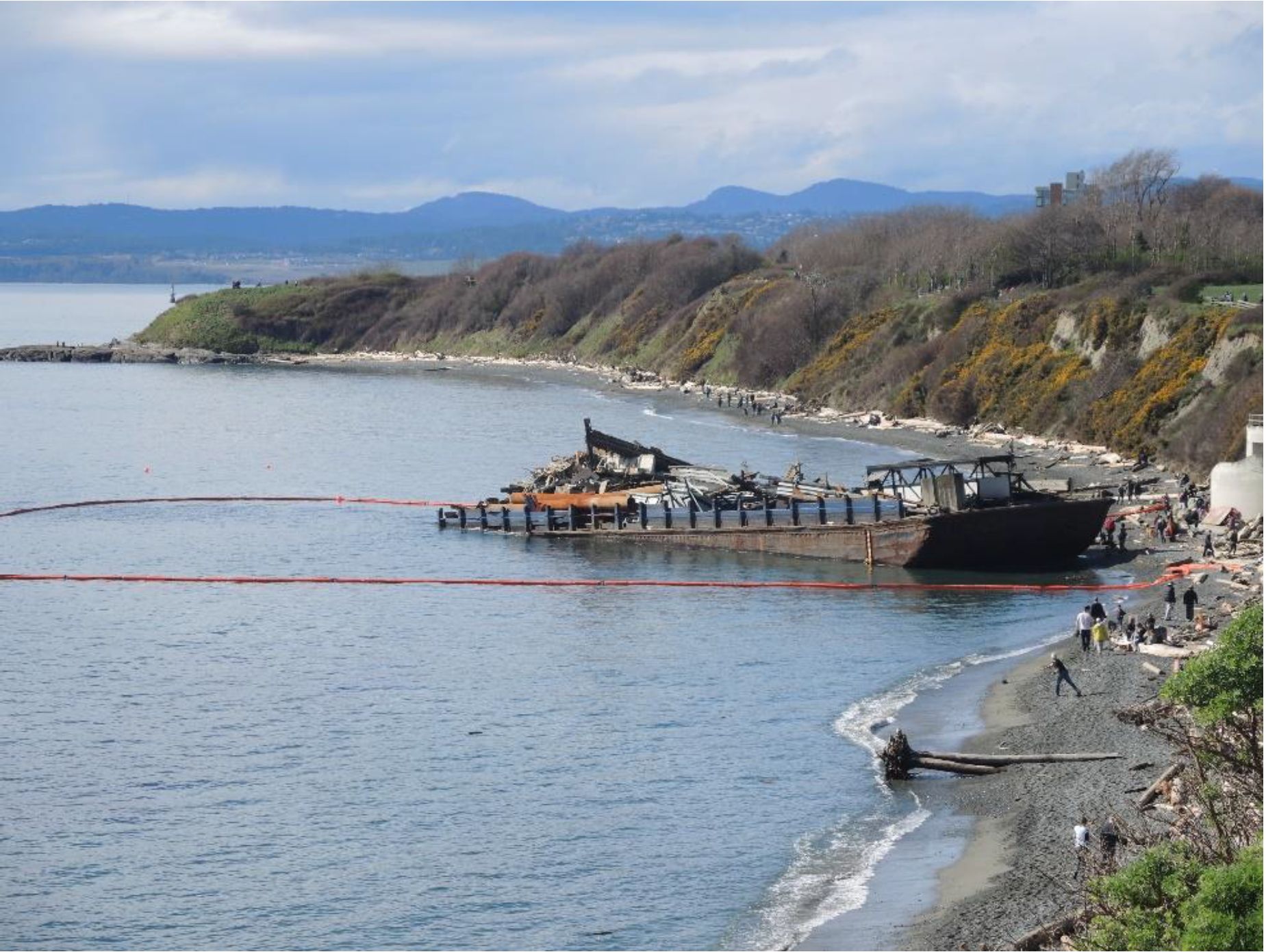
The Colonist of January 31, continued: “He started to carve his find. The rock is not real sandstone but another kind of rock used by First Nations that turns black and shiny when it’s polished, said Boudreau. …When his carving disappeared, he assumed it had been stolen because he had tucked it way up on the shore …There’s no way the waves would ever take it away. …The 65-year-old security guard believes people carried it off in a boat, but were forced to dump it. …Still, he was also surprised that the carving — more Easter Island than Vancouver Island — was mistaken for a First Nation’s artifact. It looks more exotic …But what is embarrassing to me is that, if it was beautiful and I’d finished it, people would look at it and say ‘Oh, it’s so awesome.’ But it was so ugly. I only worked on it for 15 hours or so. It wasn’t up to standard. I would have liked better bragging rights. …It’s funny how it grew legs. … It took on a whole new life. Maybe there’s something spiritual in that rock that keeps raising its head.”
If the blank stone that Boudreau carved had fallen off the barge to the east of the spiral staircase it was a considerable distance away from where it was found and would have required much effort to get it to that location.
Boudreau gives a clue to how the sandstone pillar looked before he carved it when he says: “I would still like to lend to the idea that it could have actually been in the hands of First Nations people at one time because it was too perfect There could be some First Nation attachment to that pillar. It could have just been in the water for so long that it took off every face that was on there that you could describe from the First Nations and that is how it ended up so perfectly rectangular in our water.”
When CTV News of March 25, 2019, showed that Ray Boudreau was the carver of most of the recent carvings on Clover Point, Boudreau texted that someone else made at least one of those carvings with the face on a rounded boulder. This was left in the news as “a mystery”, but Boudreau knew who the other carver was, as he revealed that person earlier on March 5, 2017 on his SSNAP Facebook page in commentary surrounding the Saltspring National Art Prize:
“I believe that Angleo Ferrari is probably the greatest “Rock Carver” alive and he is coming to Salt Spring very soon. He wanted to know if he can hammer all of the sandstone, into submission, on Salt Spring. There is some of his stuff on my page that he has gone public with on Clover Point that is not finished yet I think all sand stone should be persevered, this is an effort to do just that and inspire our beautiful inheritance”.
The More Recent Knowledge of Indigenous Weathermen.
In the 1970s I spent time taking to the late Chief John Albany about things he remembered. I asked if he had observed any remnants of earlier Lekwungen practices such as those surrounding activities of the First Salmon Ceremonies. As a boy John went fishing with his uncles, mostly out in the Albert Head area. John did not remember any ritual activities of his uncles while fishing but he was aware of the newspaper interviews with Songhees Jimmy Fraser and others in the 1950s, who were recognized as “weathermen” and often asked by reporters what kind of a winter or spring we were going to have.
One of the Indigenous people consulted as late as November 22, 1956 was Peter Jones (c. 1870-Nov. 7, 1958), then acting chief of the Tseycum Reserve. He was born at Green Point in Cowichan. His father was Peter Jones senior and his mother Julia Thomas from Cowichan. Peter was interviewed at the age of 86. The newspaper indicated:
“He has been predicting the weather for 70 years and Indians come from miles around seeking his advice.” He is quoted as saying: “In the old times the Indians would go to certain places in the hills and make a big noise by hammering a tin can to make it rain Now the planes make a big noise and it rains all the time.” The author Merriman notes: “The old Indian has the reputation of being able to talk to certain stones in the district and make it rain. The Indians used to ask him what month would bring the heavy rain. That month they did not go fishing, waiting around home for the rains to go by” (Merriman 1956).
It appears that no living person today has seen examples of large stone figures and the 1880s oral traditions of those at Finlayson Point do not describe what they looked like. Large carved stone figures found elsewhere are very different from what is termed modern Salish art. Identifying these large stones as potential ritual stones will be restricted to subjective statements on the context in which they are found – such as on a prominent point overlooking the sea or buried with other associated structures or material of a likely ritual nature.
Conclusion
When the carved stone figure turned up on the beach. I could not observe any physical evidence that it was of a recent nature. The location was within the context of a Lekwungen cultural landscape with an oral history of ritual stone figures near the location. Given the importance of large stone figures in Indigenous cultures on the southern coast of British Columbia, I thought it was best to lean on the side of recognizing that this stone figure was likely one of the ritual stones. I planned to carry on further work to examine physical evidence when time allowed.
In the Greater Victoria region there were, at least, two Indigenous people who were known as predictors of the weather as late as the 1950s. There may be a number of Indigenous people on the South end of Vancouver Island who remember references to these people or knew them in their childhood, especially as these specialists were occasionally the subject of newspaper stories.
However, no one alive today would have ever seen any of the stone ritual figures of the type that were last used in the late 19th century. There is no documentation of what the ritual stones “not far” from Finlayson Point looked like. There is only a description of the two plain pillars and one stone figure that may have been a naturally shaped stone, in the Cadboro Bay area. The only way for anyone today, including myself, could determine whether a large carved stone object is an old ritual stone or a recently made one is by the use of direct observation – which would be difficult if no one knows what they are supposed to look like.
It is much easier to determine if it is a recent one. The evidence would include obvious marks made by steel chisels or power tool marks – unless, as in this case, they were eroded away due to the nature of the softer sandstone. In some cases, depending on the type of stone, a clear giveaway is the lack of a surface patina which develops through long term chemical alterations to a stone. Having a combination of images of a stone figure being made recently and of a similarity of design features of a stone with modern, non-indigenous carvings is, of course, a reasonably definitive conclusion.
The question remains, as to weather the face on the stone figure was carved recently on an actual ceremonial stone that had previously been partially ground into shape and had fallen to the beach. How the heavy stone figure came to this location so far from where it was carved is still unexplained. The person, who first pointed out the stone figure to Bernhard Spaltholz to find, never came forward in spite of all the publicity. There is one hypothesis that may now need to be reconsidered. Could unknown people who read my 2012, on line article about stone figures being at this location decide to place one where it would be found at low tide to fool any archaeologists. If this was the case, they temporarily succeeded.
Considerations for the Future
The carving of beach petroglyphs, as opposed to large stone figures, was not a practice of the Lekwungen but is a long tradition among many Indigenous cultures of British Columbia. Many of the Indigenous petroglyphs still remain to be thoroughly documented. I am concerned that someone may unknowingly carve over some of the very faded ones or even vandalize known ancient sites – as we know has already been done. We need to ask the question – is it disrespectable for people today to be allowed to randomly carve rocks in indigenous territories where petroglyph carving was a long-time practice?
Appendix 1 Recovery of the Stone Figure
On July 12th 2020, Bernhard Spalteholz was walking along the beach at a zero tide below Beacon Hill Park. An unidentified man had told him about a carved stone on the beach. Bernhard found it, took a photograph to show where the stone was in relation to the shoreline and contacted the Museum. By the time I got the message the tides were too high to find the stone.
The Team Effort to Bring it Out
On July 16, I thought I would try the 0.8m low tide just in case the stone might be visible. Fortunately my friend Tom Bown, a research associate at the RBCM, came with his wet suit trousers. Tom walked into the water and found it right away in the incoming waves.
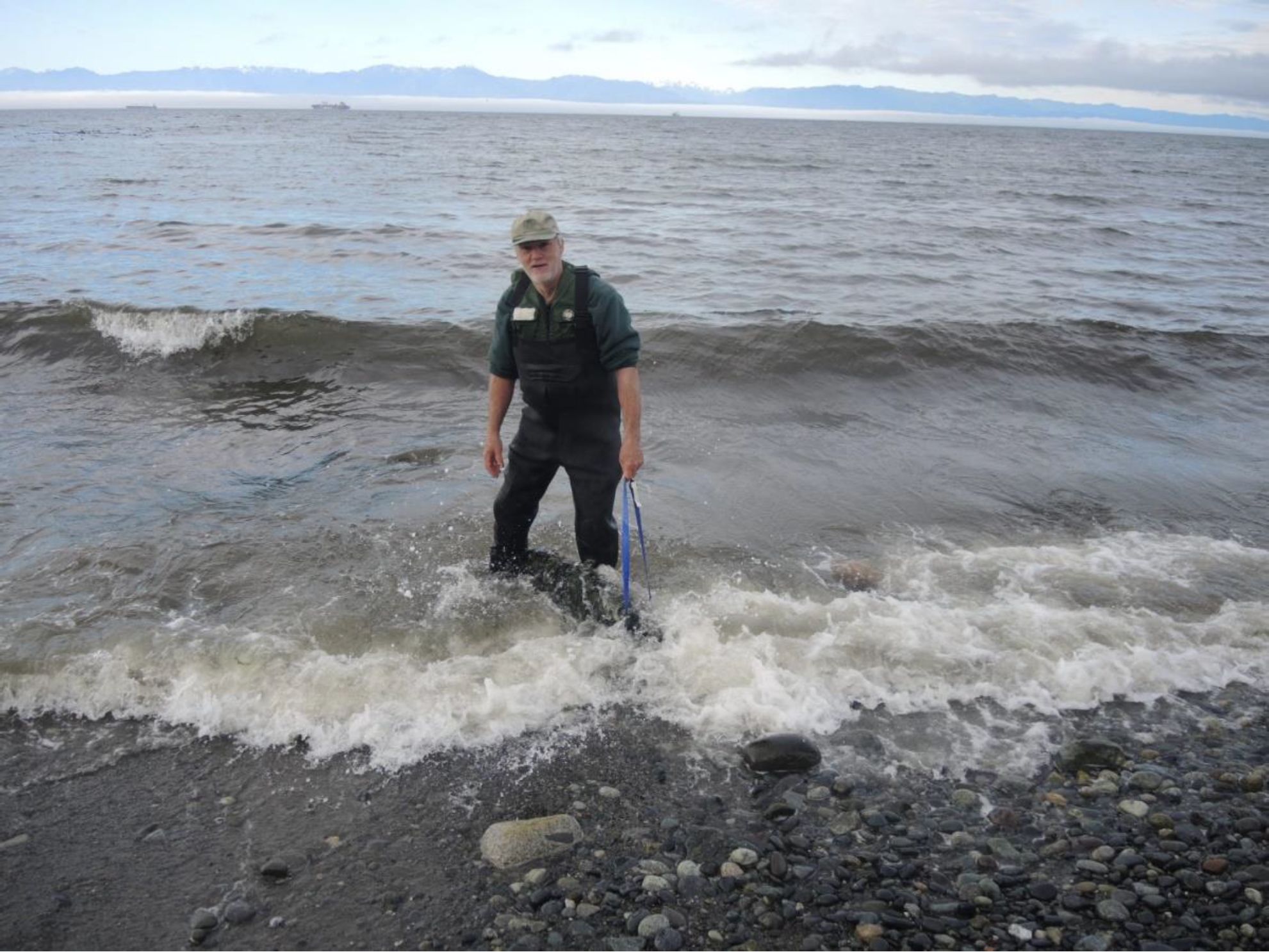
The stone was much bigger and heavier than we had thought – later shown to be 240 lbs. It now became apparent that recovering it would be much more involved than I had anticipated. But I thought it was imperative to get it off the beach.
Tom and I wriggled it out of the water and tied it with ropes and a lifting stick, and with my wife Freya’s help, the three of us slowly half lifted, pulled and slid it up hill along an improvised beach log railway. Tom’s rubber tot container served to protect the carved face.
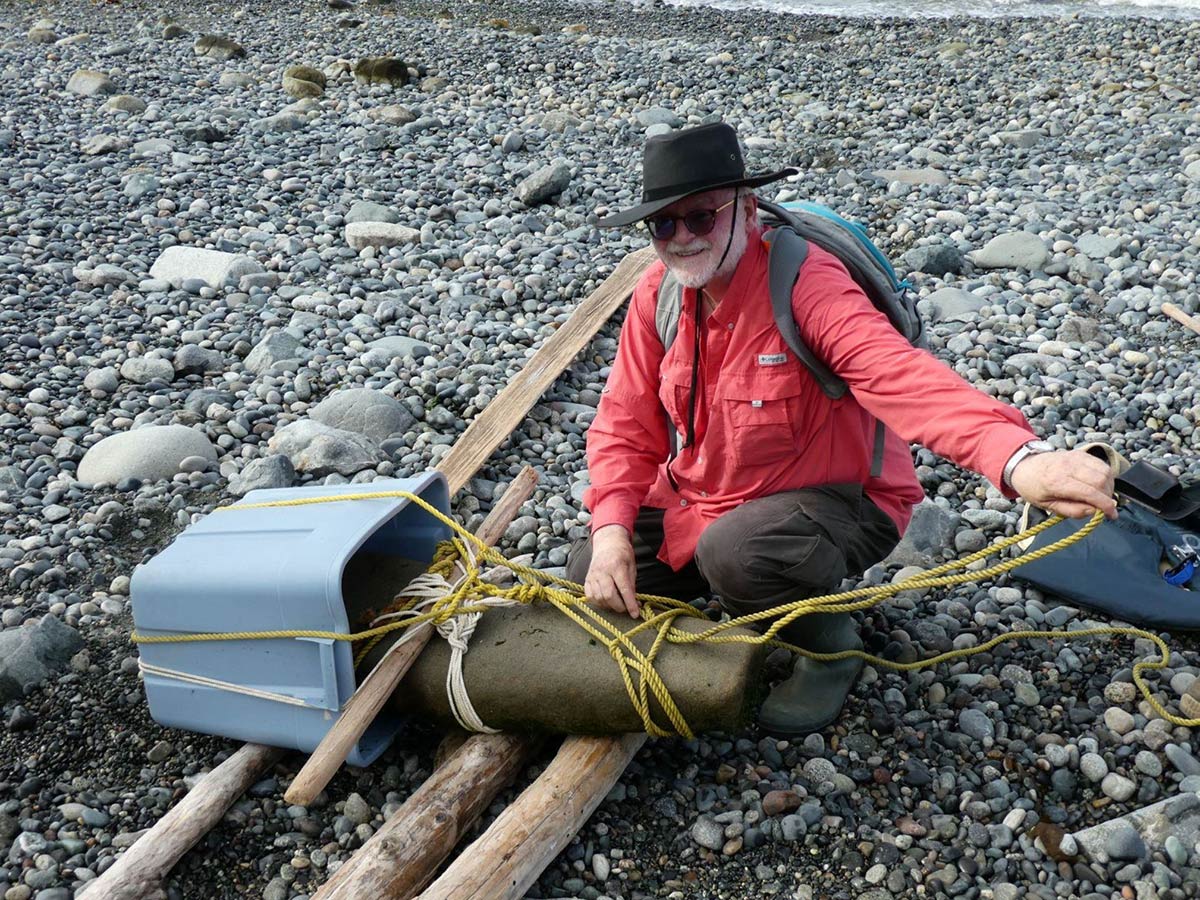
Realizing it was going to be a problem to get the heavy stone the long distance down the beach, Tom phoned his friend David Carl. David generously came to save the day with his truck loaded with a fridge dolly and sheets of plywood to run the dolly on. Paul Ferguson, the museums history collections manager, joined us and we all put in a big effort to get the heavy dolly load down the constantly moving plywood and up the spiral stairs from the beach.
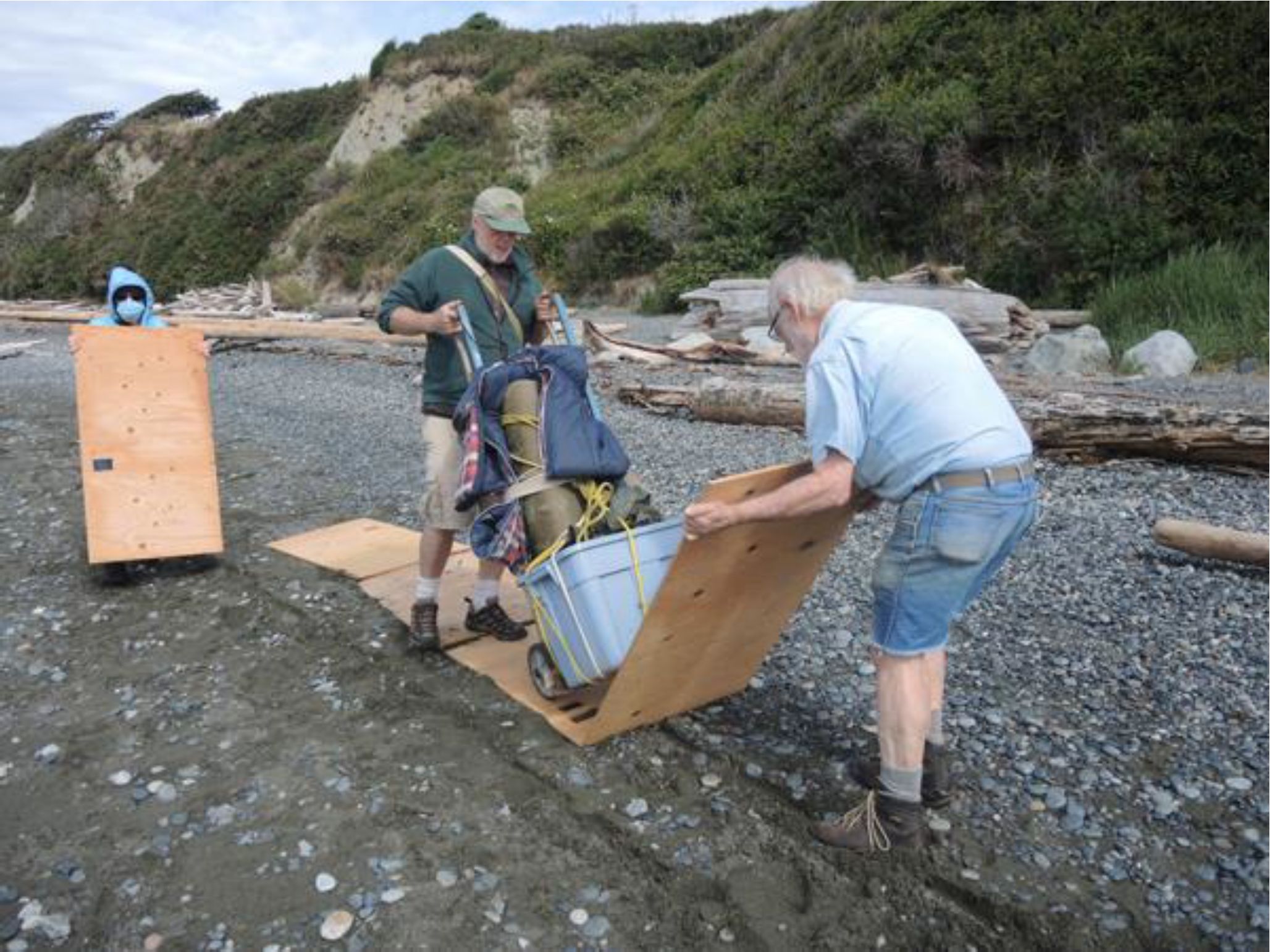
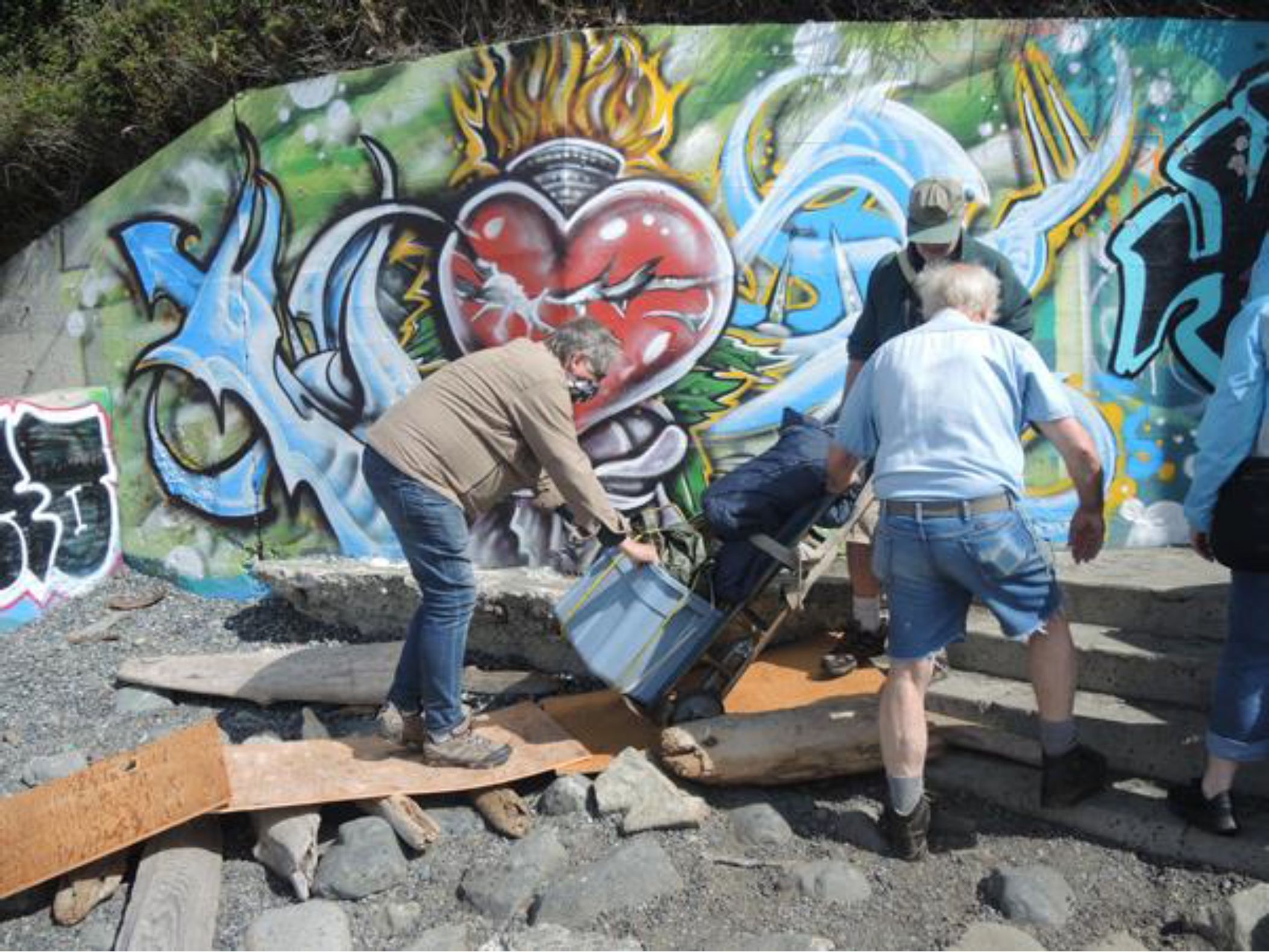
We took the stone figure back to the Museum loading dock where our conservator Megan Doxsey-Whitfield kept the carving wet and covered it in plastic while plans could be made for its treatment. She explained that we needed to put it in a distilled water bath to desalinate it, and remove the layer of algae growing mostly on one side. Wet archaeological objects typically require prompt conservation attention because uncontrolled drying can cause irreversible damage. Removing the salt before it dries out reduces the risk of this happening.
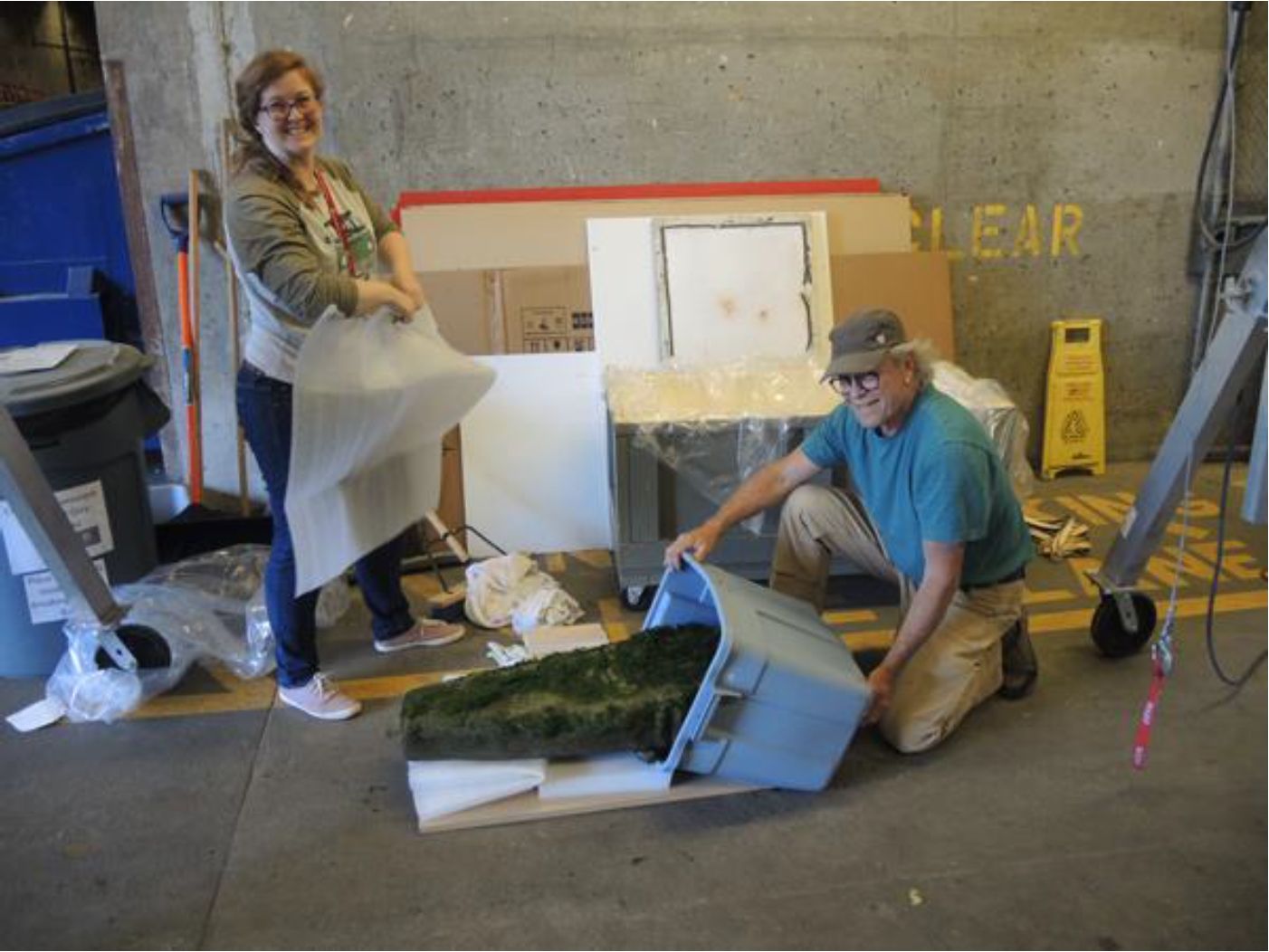
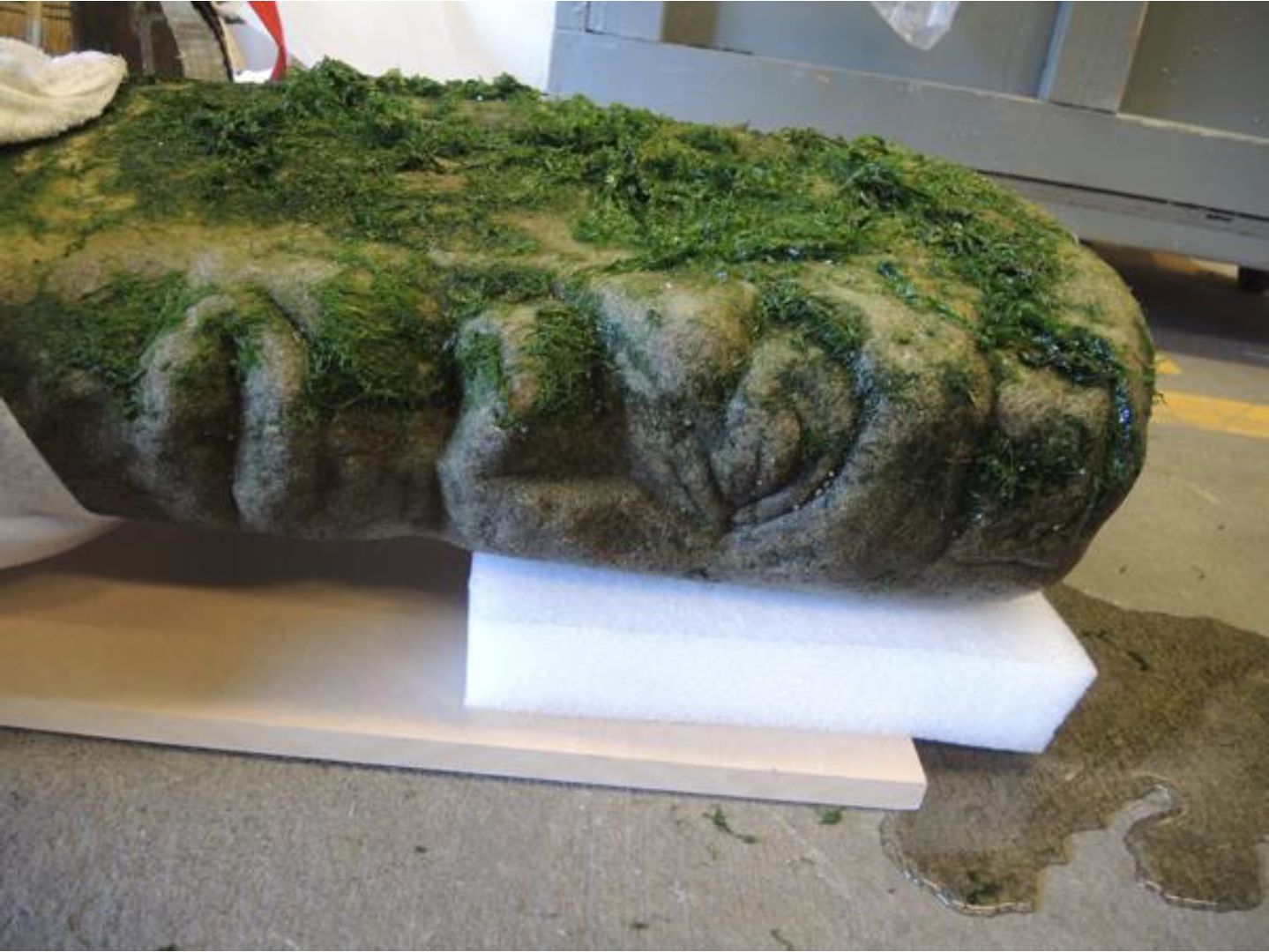
This became a major concern. Where do we find a container big enough for this large piece of sandstone and how do we get it into and out of the water vat?
Our curator of Vertebrate Zoology, Gavin Hanke, found an old fibreglass tank. He and Megan cleaned it out and got it ready with a double layer of sheet plastic and foam supports inside. The how to lift it problem was solved by our exhibits technician Pat Swift with an electronic lift. We got the artifact prepared and Pat lifted it safely into the fish tank box. Fortunately the fish tank had wheels and we took it upstairs to the conservation lab where Megan could now begin further conservation of the artifact.
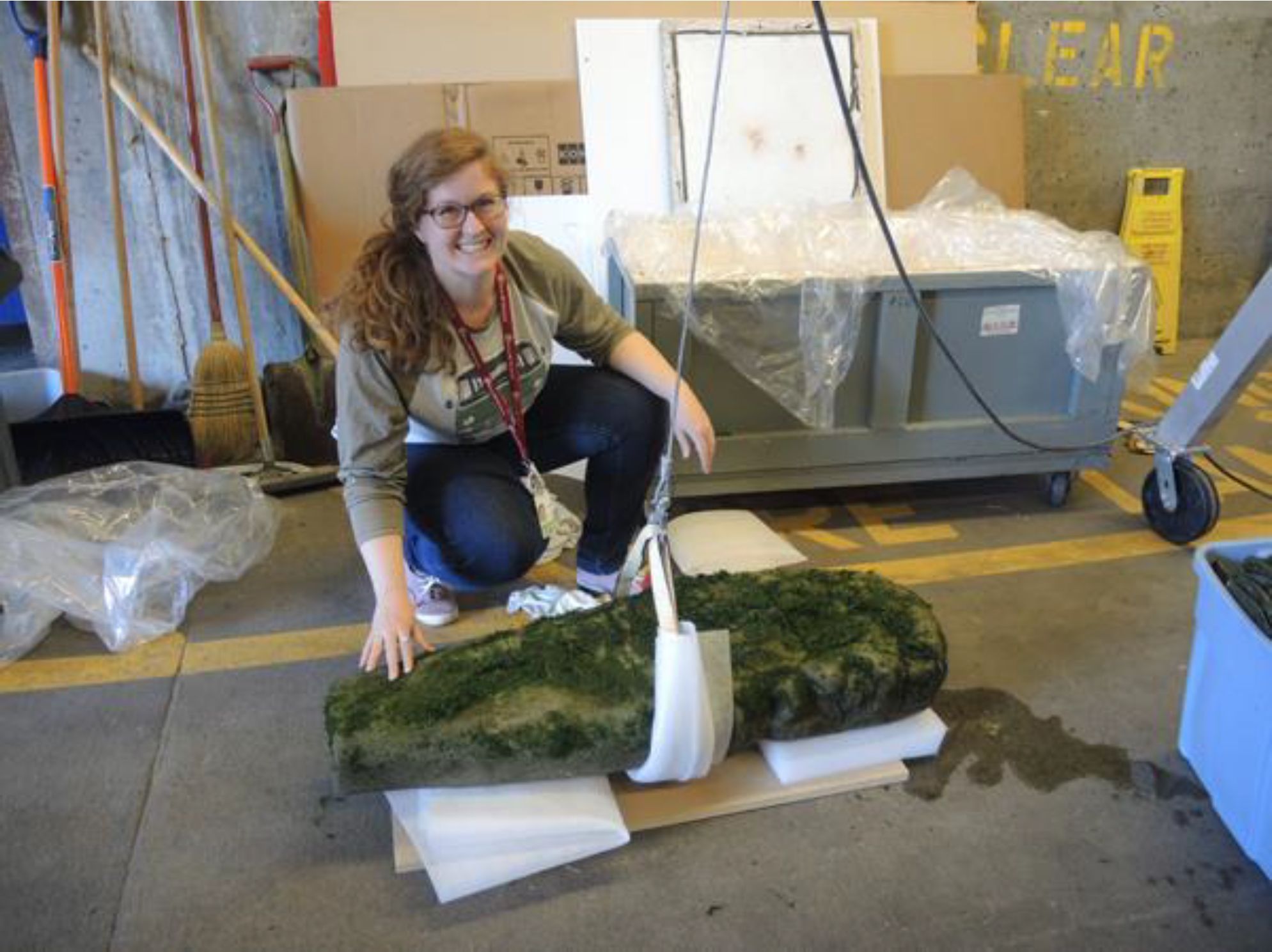
References
Boas, Franz. 1891. Second General Report on the Indians of British Columbia, 1890. In: Report of the north-western Tribes of Canada, Vol. 6. British Association for the Advancement of Science.
Deans, James. 1891. Yicsack, or The Hat. The American Antiquarian, 1(3)170171. Albany, Oregon.
Merriman, Alec. 1956. Aircraft Make it Rain. Chief Forecasts White Christmas. The Daily Colonist November 22.
Gleeson, Paul F. 2001. Ozette Wood Working Technology. Coyote Press.
Keddie, Grant 1993. Finlayson Point, Victoria. Heritage Resource Management of Sidewalk Construction. Report to the Archaeology Branch. Permit No. 1992-109.
Keddie, Grant. 2003. A New Look at Stone Bowls. In: Archaeology of Coastal British Columbia. Essays in Honour of Professor Phillip M. Hobler. Ed. by Roy L. Carlson. Archaeology Press, Simon Fraser University, Burnaby B.C. pp. 165-174.
Keddie, Grant. 2012. Changing the Weather in Songees Tradition.
Schaepe, David and Herb Joe. 2006. Stone T’ixwelatsa Repatriation Report & Supplement Report I. Submitted by: The Nooksack Indian Tribe Nooksack, Washington To: The Burke Museum of Natural History and Culture Seattle, Washington As prepared by David Schaepe (October 2005).
